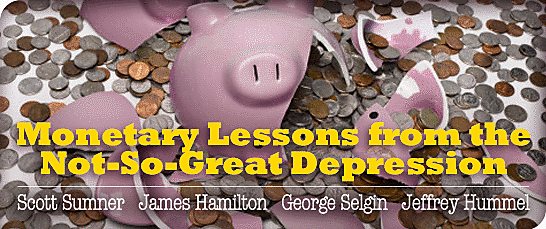Accounting for the Great Depression and devising plans for preventing a sequel has been a major preoccupation of monetary and macroeconomics for over seventy years now. If the sometimes vitriolic infighting raging now within the economics profession is any indication, our recent recession and financial collapse may play a similar role for years to come. Did Bernanke display a virtuoso touch and keep a bad thing from becoming worse? Or did the Fed drive the economy over the edge by compounding prior errors with fresh mistakes?
Until the Milton Friedmans and Anna Schwartzes of our “great recession” emerge, try this month’s Cato Unbound for some preliminary answers. We’ve recruited a panel of top-notch money specialists to tease out some of the key monetary lessons from the present mess, and here’s a quick gloss on what they’ve said so far.
In our lead essay, Bentley University economist Scott Sumner, a specialist on the Great Depression, stands against conventional wisdom in arguing that monetary policy in the period running up to the carnage in the financial sector was disastrously contractionary. Easier money, Sumner says, might have prevented the worst. He proposes a new strategy for central bankers — targeting forecasts of nominal GDP — that might help avert future crises. Sumner warns of the political dangers of misdiagnosing the crisis: unless the record is set straight, free markets will once again take the fall for a flubbed central banking.
In his reply essay, “It’s Harder than it Looks,” James Hamilton of UCSD and the popular blog Econbrowser disagrees with some, but agrees with much of Sumner’s diagnosis, including the claim that the Fed could have done better and might have limited the damage of the financial crisis had it pushed rates of nominal GDP growth higher than they were. But Hamilton points out that this is easier said than done and raises doubts about the practicability of Sumner’s preferred targeting strategy.
Cato senior fellow and University of Georgia economist George Selgin agrees with Sumner that “tight money was the proximate cause of the post-September 2008 recession” and that “a policy of nominal income growth targeting might have prevented the recession.” But Selgin encourages Sumner to acknowledge the role easy money played in the subprime crisis, and argues that Sumner’s favored five-percent nominal income-growth target is “unnecessarily and perhaps dangerously high.” Selgin favors a lower target and tolerance for some price deflation, a strategy he contends would be less likely to perpetuate boom-bust cycles.
In the last of this issue’s formal replies, San Jose State’s Jeffrey Rogers Hummel sees merit in much of Sumner’s account of the causes of the financial crisis, but he doubts a better rule for central bankers will keep us out of trouble in the future. Hummel contends that “only abolition of the Fed, elimination of government fiat money, and complete deregulation of banks and other financial institutions offer any long-term hope of bringing better macroeconomic stability.”
Stay tuned as our panelists continue to hash it out in free-for-all blog chat that begins Wednesday. And if this is the sort of thing that revs your engine, don’t forget about Cato’s annual monetary policy conference coming up in November.

